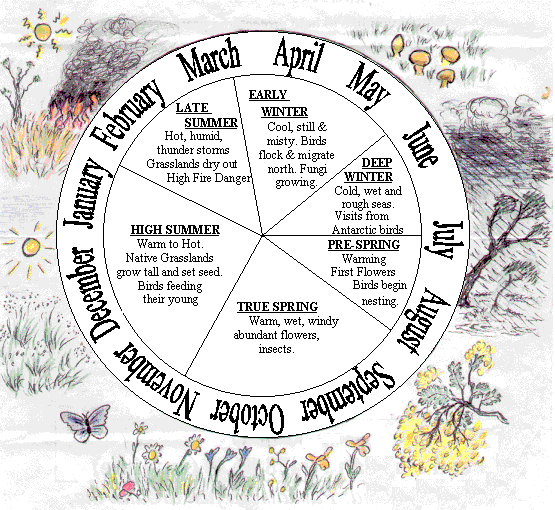Here we are, solidly a “week” into “Spring.” In Melbourne, this means there’s nothing different to last month; it’s max 13C, there’s winds and rain, and this afternoon the possibility of hail.
So now seems like a good reminder: Spring is an artificial concept imported and imposed upon the Australian landscape when those invaders should have been chatting to the Traditional Owners about the six (or seven, or two) seasons. (It goes without saying that it’s all about imperialism and racism that we don’t talk about this stuff even now, but comment if you wanna chat about it)
Being from Perth, Steph is about to focus on the six seasons of the Nyoongar people, with brief diversions into Wirrudjeri (Eastern) seasons.
We’ll start with a reminder that seasonal calendars don’t match up with the Gregorian calendar, because the Gregorian calendar is an artificial concept imported and imposed upon the Australian landscape, along with the completely illogical European seasons. And of course there are different seasons across the whole continent, but Steph is only talking to the ones she knows. Okay, good. Now:
Perth. The South-West, a huge chunk of the continent. The Nyoongar seasonal calendar is six seasons long, yes, perfect. They don’t match up with the Gregorian calendar, but approximately:
December – January = Birak, dry and hot
February – March = Bunuru, hottest part of the year (and if you’re from Perth/the West Coast, you know this. You know this so hard, I’m melting just thinking about it).
April – May = Djeran, cooler weather begins
June – July = Makuru, coldest, wettest, stormiest (Steph and her family always went back to Malaysia for this time)
August – September = Djilba, combination of wet days and an increasing number of delightfully warm days with cold, clear nights.
October – November = Kambarang, longer dry periods
If you’re from the West Coast, and you’ve never heard of these seasons, think about how you feel in each of these months and then match them up. See how much comfortable they feel than Spring, Summer, Winter, Autumn and their arbitrary dates?
Okay for the rest of you:
The Kulin and Wurundjeri people have seven seasons, along with two non-annual seasons (flood season, approx. every 28 years, and fire season, approx. every seven years). These seasons are Kangaroo Apple Season (December), Biderap dry season, January and February, Eel Season (March), ‘Waring Wombat Season’, about April – July, with highest rainfall and lowest temperatures, Orchid Season (approx. August-September), Tadpole Season (October), and the Grass-Flowering Season in about November.
Sidenote: In further evidence that seasons are artificially imposed, I’d like to end with a reminder that Chinese also has more than four seasons. There are five, and literally as I’m typing this I’m wondering if that’s related to Taoism and the 五行, IT IS, MY WHOLE LIFE IS MY RELIGION OH WOW mind blown okay so they’re 春, 夏, 长夏,秋,冬.
Further reading:
- Indigenous seasons at the BoM, with 10 different groups on there (including a whole lot of traditional owners from the top end) and also this table thingy.
- Specifically Kakadu and Uluru-Kata Tjuta.
- This totally amazing Larrakia Nation seasonal calendar.
- This adorable Melbourne-region calendar.
- At The Lab.



And now I’m wondering if indigenous people of North America had different names for the seasons here–I’d never even thought about it before and now I need to find out. Thank you for teaching me something new!
You are welcome! Please report back with what you learn, we are very interested!
I tend to find the European seasonal names aren’t really appropriate here in Perth until we’ve passed the major astronomical milestones (equinoxes and solstices) which are supposed to mark their midpoints. So I’m not looking for “spring” to start until the other side of the Vernal Equinox, summer doesn’t really hit until after Summer Solstice, Autumn starts kicking in after the Autumnal equinox (or these days, after ANZAC day) and winter really starts to bite after the Winter Solstice has passed.
I tend to find it really funny (in the sense of “funny peculiar” rather than “funny ha ha”) that our school year here in WA starts just as the weather is about to hit its highest point. I mean, I can see it makes sense on the Gregorian calendar (it makes more sense than the Northern Hemisphere school years, really – you start a new school year with the new calendar year, it makes so much sense) but it means we have students spending the two hottest months of the year sitting in classrooms which aren’t air-conditioned (or which weren’t when I went to school back in the late 1970s through 1980s) and also having their school routine interrupted by a public holiday about every four weeks.
Pingback: The dangers of spring | No Award
Pingback: Welcome to the 89th Down Under Feminists’ Carnival | Opinions @ bluebec.com